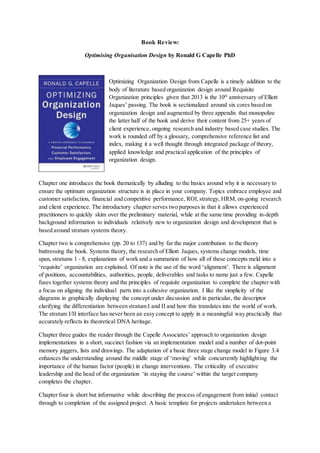
Book Review Capelle Dec 2013 V2
- 1. Book Review: Optimising Organisation Design by Ronald G Capelle PhD Optimizing Organization Design from Capelle is a timely addition to the body of literature based organization design around Requisite Organization principles given that 2013 is the 10th anniversary of Elliott Jaques’ passing. The book is sectionalized around six cores based on organization design and augmented by three appendix that monopolize the latter half of the book and derive their content from 25+ years of client experience, ongoing research and industry based case studies. The work is rounded off by a glossary, comprehensive reference list and index, making it a well thought through integrated package of theory, applied knowledge and practical application of the principles of organization design. Chapter one introduces the book thematically by alluding to the basics around why it is necessary to ensure the optimum organization structure is in place in your company. Topics embrace employee and customer satisfaction, financial and competitive performance, ROI,strategy, HRM, on-going research and client experience. The introductory chapter serves two purposes in that it allows experienced practitioners to quickly skim over the preliminary material, while at the same time providing in-depth background information to individuals relatively new to organization design and development that is based around stratum systems theory. Chapter two is comprehensive (pp. 20 to 137) and by far the major contribution to the theory buttressing the book. Systems theory, the research of Elliott Jaques, systems change models, time span, stratums 1 - 8, explanations of work and a summation of how all of these concepts meld into a ‘requisite’ organization are explained. Of note is the use of the word ‘alignment’. There is alignment of positions, accountabilities, authorities, people, deliverables and tasks to name just a few. Capelle fuses together systems theory and the principles of requisite organization to complete the chapter with a focus on aligning the individual parts into a cohesive organization. I like the simplicity of the diagrams in graphically displaying the concept under discussion and in particular, the descriptor clarifying the differentiation between stratum I and II and how this translates into the world of work. The stratum I/II interface has never been an easy concept to apply in a meaningful way practically that accurately reflects its theoretical DNA heritage. Chapter three guides the reader through the Capelle Associates’ approach to organization design implementations in a short, succinct fashion via an implementation model and a number of dot-point memory joggers, lists and drawings. The adaptation of a basic three stage change model in Figure 3.4 enhances the understanding around the middle stage of ‘moving’ while concurrently highlighting the importance of the human factor (people) in change interventions. The criticality of executive leadership and the head of the organization ‘in staying the course’ within the target company completes the chapter. Chapter four is short but informative while describing the process of engagement from initial contact through to completion of the assigned project. A basic template for projects undertaken between a
- 2. company and an external provider is introduced and what I would describe as common sense suggestions and processes are disseminated through a four step process of initial discussion, assessment,implementation and finally sustainment. Chapter five converges on ‘the role of the board’ as noted in Figure 5.1: Governance Model. Themes dealt with include selection of board members, the work of a board, projects, interface linking a CEO and the board and compensation matters. Depending on the company size, discussion around board selection more often than not embraces a conversation around the top quartile of stratum levels - certainly stratum V and above and in smaller companies IV as well. I consider this chapter as more of an introduction, rather than an analysis in depth of the appropriate stratum a board/CEO should be recruited from, or operating at. The whole issue around the C-Suite and board member selection, makeup and competencies resonates with me as being crucial and worthy of additional analysis, in a post GFC business environment. Chapter six completes the theory section underpinning the book with a ‘call to action’ constructed around Capelle’s 10 reasons on why organisations tend not to optimize their organization’s design. Working through this section a number of times is well worth the effort as the research supporting the assertions is solid, having been amassed through a client database over an extended period of time. Appendix A describes client experience, appendix B is grounded in the research of Capelle Associates while appendix C introduces four case studies straddling financial services,railways, power generation and health care. Combined, the appendix make up half of the book’s mass and are a rich vein of practical examples to complement the theoretical aspects of organizational design. Optimizing Organization Design is a substantive work comprising 462 pages in traditional hard cover paper version or e-book. This book is not ‘organization design for dummies’ or a basic ‘how to do it manual’ but an extensively researched and written addition to the current field of knowledge. The book/e-book is a worthwhile purchase if you are interested in a contemporary reference on process, theory and practice of organization design based around the principles of Elliott Jaques’ Requisite Organization. Optimizing Organization Design’s peerage is underwritten by 25+ years of consulting experience from Capelle Associates spanning a diverse range of industries utilizing elementary five stratum business unit structures through to the C-Suite and board room at stratum six and above. You will not be disappointed if you purchase this book to help you better understand the inter-connectivity and alignment between the building blocks for the optimization of organization design. Reviewed by Paul Lynch PhD December 2013